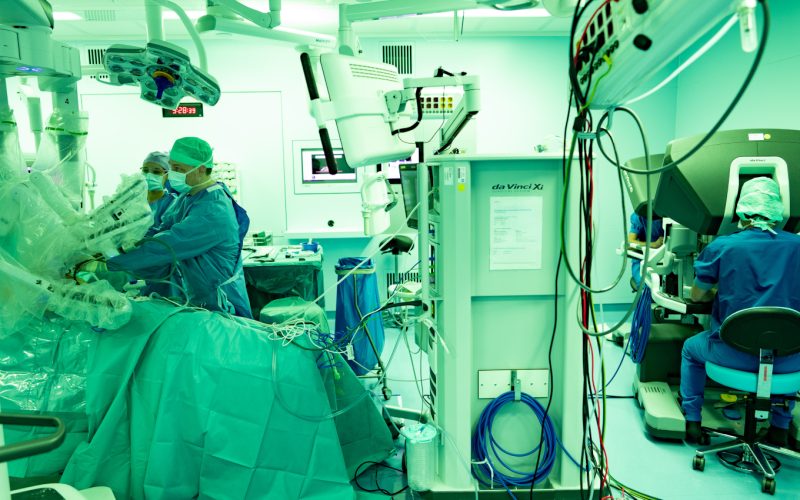Technological help has become indispensable in the operating room. Using robotic arms, surgeons are now performing operations that were previously thought impossible. We explore the wonderful world of robotic surgery, which this year is celebrating its 25th anniversary in the Netherlands.
The social debate about the role of technology has been in full swing for a while now. Accompanied, of course, by some anxious scenarios. Will artificial intelligence cost people their jobs? Will entire professional groups perish as a result? Will we lose sight of each other, resulting in less social contact? In between all these worries, we would almost forget that technology can indeed make our lives a lot easier and more advanced.
This is certainly the case with robotic surgery. What exactly does robotic surgery entail? How does it benefit the patient? How will it help healthcare professionals? And aren’t these robots too expensive to implement in healthcare? We take a moment to reflect on 25 years of robotic surgery with Jelle Ruurda. He is a gastrointestinal and oncological surgeon, professor of robot-assisted minimally invasive surgery at UMC Utrecht and chairman of the Dutch Robotic Surgery Working Group.
Faster recovery
In August 2000, gastrointestinal surgeon Ivo Broeders performed the first robotic surgery in the Netherlands, at UMC Utrecht. Jelle, who had just finished medical school, was allowed to be present. “I had just come out of college but even then I saw how smoothly the operation went, and how enthusiastic the entire surgical team was. Now, exactly 25 years later, I still experience that enthusiasm when I work with the robot. And that’s not because it’s a fun hobby but because the added value of robotic surgery has become abundantly clear to us.”
Since that first surgery, robots in the operating room have been on the rise. In the Netherlands, we now have around 50 robots in 32 hospitals, and more than 6,000 surgical robots are used worldwide. Every year, more than 1.5 million people are operated on with them.
“Over the past 25 years, the robots have developed enormously and so have the surgeons handling them. We operate much more precisely with the help of the robots”, Jelle says.
Teamwork at its best
Surgical robots, such as the Da Vinci robot, have surgical instruments with tiny movable wrists, and their movements can be ‘scaled’. From behind a large device, further away in the operating room, the surgeon looks in the patient live, via a camera, and controls the robotic arms via two small joysticks. This allows keyhole surgery to be performed much more precisely.
“I see better, can stitch better than I can without a robot and have complete control over the surgical field because of the precision of the technical support,” Jelle says. “Moreover, I do all this in a much better ergonomical position.”
While a surgeon handles the Da Vinci robot, another surgeon or operating assistant (depending on the complexity of the procedure) is standing right next to the patient during surgery, to perform manual work. Teamwork at its finest, along with the rest of the surgical team. “Communication is essential here, because you are no longer located next to each other, but have to work together at a slightly greater distance,” Jelle clarifies.
Less pain, faster recovery
The added value of robotic surgery has been the subject of plenty of scientific research over the years. “As a result, it has been shown for different types of surgery that patients suffer from less pain and less blood loss after robotic surgery, are on their feet faster and have to stay in the hospital for a shorter period of time,” Jelle explains.
During surgery, internal damage can also be reduced when the surgeon works with a robot. Nerves, for example, are less affected. “This is also the main reason why the majority of prostate surgeries are done with the robot. It is better to perform with the robot, and men are at less risk of incontinence and impotence.”
The robot also makes it easier to see, for example, which and how many lymph nodes need to be removed. It is important to get out as many lymph nodes with metastases as possible, but this is often difficult to determine during regular ‘open’ surgery. In robotic keyhole surgery, this is much easier to see. And not only for the operating surgeons but also for any other specialists who ‘look along’ during a complicated operation. “While sharing the operation image, I can now consult a very experienced colleague from Utrecht during a complicated esophagectomy but also just as easily a surgeon from Shanghai, where they do some 2,000 esophagectomies a year.”
Pushing boundaries
Thanks to the operating robot, it has now become possible to operate on patients who were previously thought ineligible for surgery. Jelle and his team often operate on such patients, who have been referred from other hospitals, for example.

Jelle Ruurda
Jelle treated several patients with a tumor attached to the trachea, for instance. Surgery was not technically possible at the hospital where they were being treated. At UMC Utrecht, the patients first received radiotherapy and chemotherapy to shrink the tumor and loosen it from the trachea. Then Jelle operated on them with the robot, and the entire tumor could be removed.
“The tumor must then be detached from the trachea very precisely, on a microscopic level, millimeter by millimeter. That would not be possible without a robot. That’s how the boundaries are really being pushed.”
Because of the possibilities of robotic surgery, it has become all the more important for hospitals to work together. “Despite the fact that the Dutch healthcare system is in the top three on all lists worldwide, large differences between hospitals can result in people mistakenly ending up in palliative care.” By working together and knowing what is possible at which hospital, doctors can refer their patients to another hospital for the treatment they need most at that time.
Within the Utrecht region, therefore, nine hospitals have joined forces within ONCOMID (Oncologie Midden-Nederland). Within multidisciplinary teams, they discuss how and where their patients can best be treated within the Utrecht region.
In particular, Jelle works extensively within RAKU (Regionaal Academisch Kankercentrum Utrecht). This cooperation is part of ONCOMID, within which six hospitals work together to provide the best treatment for tumors in the esophagus, stomach, pancreas, gallbladder and liver. “We now cooperate whereas we saw each other as competitors before. This has tremendous added value for healthcare. The idea that hospitals have to compete is fortunately losing more and more ground and is certainly outdated for high-complex care.”
Less pressure for healthcare
Today, we are having to deal with a healthcare system that is under severe strain, with a chronic shortage of healthcare personnel and long waiting lists. Robotic surgery can help to relieve the pressure. Medical technology can, for instance, take over tasks that currently have to be postponed or put off because of the shortage of healthcare personnel. Jelle: “In robotic surgery, we often operate with one less person, because a surgeon can control four arms, and there are many more examples.”
In addition, Jelle thinks innovations such as robotic surgery will make working in healthcare more appealing to young people. “Millennials and Generation Z are attracted to the digital world and technology. If a hospital makes the choice to bring in the latest technological advances, it may attract new talent and improve the image of working in healthcare.”
Expensive technology?
But what about the cost? Aren’t robots too expensive, especially with healthcare costs already skyrocketing? Purchasing a robot in the operating room costs an average of 1.5 to 2 million euros. In total, we now spend about 25 million euros annually on surgery with robots in the Netherlands.
“That may seem like a lot but if you express it in costs per patient, it comes to about 2,500 euros per patient,” Jelle clarifies. By comparison, radiation devices cost from about 5 million euros each, on average. And the immunotherapy drug Nivolumab amounts to some 70,000 euros per patient.
“Therefore, it is certainly not right to dismiss robotic surgery as an expensive technology. And with competition and increasing innovation, the costs of robotic surgery will only continue to decrease.”
The extra expenses of robotic surgery are also compensated by shorter hospitalization, faster recovery and fewer complications, Jelle points out. “In esophagectomies, for example, the length of hospitalization has been reduced from 16 to 6 days, and in bladder operations from 10 to 5 days.” Patients can get out of bed sooner, are released from drains earlier and receive pain relief without IVs or epidurals sooner. “That would not have not been possible without minimally invasive surgery.”
What will the future bring?
A quarter of a century ago, Jelle, fresh out of college, looked on in amazement at that very first robotic surgery in the Netherlands. What can we expect in the next 25 years?
“In the Netherlands, we have enormous knowledge about robotics at our universities of technology. With this we can take a huge lead in the digitization of surgeries.” UMC Utrecht therefore works closely with the universities of technology, industry, other universities and research institutions. This happens, for example, within the EWUU, UMC Utrecht’s partnership with Eindhoven University of Technology, Wageningen University and Utrecht University.
“With Eindhoven University of Technology, for example, we are developing an algorithm that can quickly recognize and map structures of a patient’s chest. The surgeon can then add those structures to the surgical image and use them as a kind of Google Maps during surgery to navigate through the patient’s chest.”
Jelle expects that in the near future such applications will become standard in surgery, and that procedures will become even less invasive. “Also, the future vision of being able to take over part of the surgery from behind a home console is closer than we think, although, of course, there are still some legal and ethical hurdles to overcome.”
Technology will play an increasing role in surgery, and Jelle is convinced that the Netherlands can play a pioneering role in this. “We have all the knowledge and expertise in the Netherlands to play a role in this. Cooperation between universities of technology and doctors is essential for this. Computer scientists, biomechanical engineers and doctors must join forces to transform the operating room from an analog to a digital world, in which we get help from robotics, but also from artificial intelligence to support our decision-making.”
